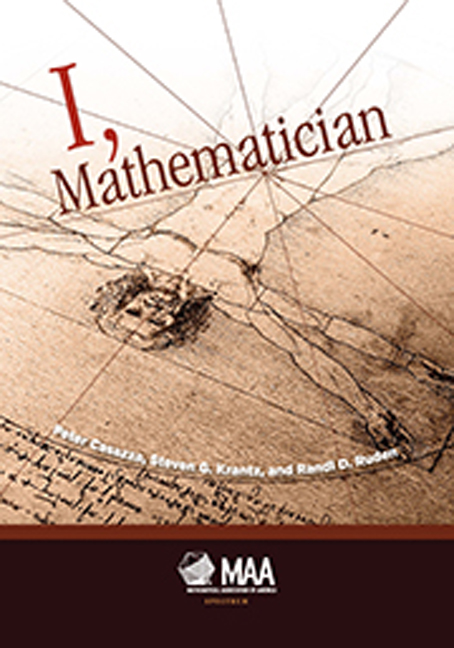Book contents
- Frontmatter
- Contents
- Preface
- Part 1 Who Are Mathematicians?
- Foreword to Who Are Mathematicians?
- 1 Mathematicians and Mathematics
- 2 What Are Mathematicians Really Like? Observations of a Spouse
- 3 Mathematics: Art and Science
- 4 A Mathematician's Survival Guide
- 5 We Are Different
- 6 The Naked Lecturer
- 7 Through a Glass Darkly
- 8 What's a Nice Guy Like Me Doing in a Place Like This?
- 9 A Mathematician's Eye View
- 10 I am a Mathematician
- Part II On Becoming a Mathematician
- Part III Why I Became a Mathematician
3 - Mathematics: Art and Science
from Part 1 - Who Are Mathematicians?
- Frontmatter
- Contents
- Preface
- Part 1 Who Are Mathematicians?
- Foreword to Who Are Mathematicians?
- 1 Mathematicians and Mathematics
- 2 What Are Mathematicians Really Like? Observations of a Spouse
- 3 Mathematics: Art and Science
- 4 A Mathematician's Survival Guide
- 5 We Are Different
- 6 The Naked Lecturer
- 7 Through a Glass Darkly
- 8 What's a Nice Guy Like Me Doing in a Place Like This?
- 9 A Mathematician's Eye View
- 10 I am a Mathematician
- Part II On Becoming a Mathematician
- Part III Why I Became a Mathematician
Summary
“Cogito ergo sum” said the mathematician and philosopher René Descartes, highlighting the fact that mathematicians are thinkers. Our brain is our only tool and we live and work in a world of ideas. In theory we could work on a desert island or, like Jean Leray, in a prisoner-of-war camp. All we need is peace and solitude to allow our brains to explore the mysterious world of mathematical ideas.
This self-sufficiency is no doubt one of the reasons why the general public view the mathematician with amixture of awe and incomprehension. It also explains why, in extreme cases, mathematicians live at times on the verge of insanity. Total immersion in the abstract world of ideas is a demanding discipline and when taken to extremes it can overwhelm.
But mathematicians are not unique in this respect. Art can be as harsh and many famous artists have found themselves on the thin line that separates creative concentration from delusion or depression as with Goya or van Gogh. Isolation and introversion can foster the creative imagination but they can also be psychologically disturbing, as with the famous Austrian logician Kurt Gödel.
But if mathematics shares the freedom of creative thought with art, it is also close to natural science and so gets anchored to the physical world. Mathematics faces both ways; it is both art and science, and its practitioners serve two masters, Beauty and Truth. How to reconcile these apparently contradictory gods is a conundrum that lies at the heart of mathematics, and each mathematician has to solve it in his own way.
That beauty and truth can, on occasion, live happily in harness is clearly shown by Newton's deduction of the elliptical orbits of the planets from the inverse square law of gravitational attraction. This is a beautiful explanation of an important scientific fact.
Both art and science are human activities that have their own evolution, but there is a fundamental difference. Science is hierarchical, all discoveries build on earlier work and aim at a unification of knowledge. Newton would recognize the advances made by James Clerk Maxwell and Einstein. It is much less clear what Bach would have made of twentieth century music.
A related aspect of the difference between art and science is that, while both depend ultimately on the spark of individual genius, science is collaborative in a way that art is not.
- Type
- Chapter
- Information
- I, Mathematician , pp. 29 - 30Publisher: Mathematical Association of AmericaPrint publication year: 2015
- 2
- Cited by



